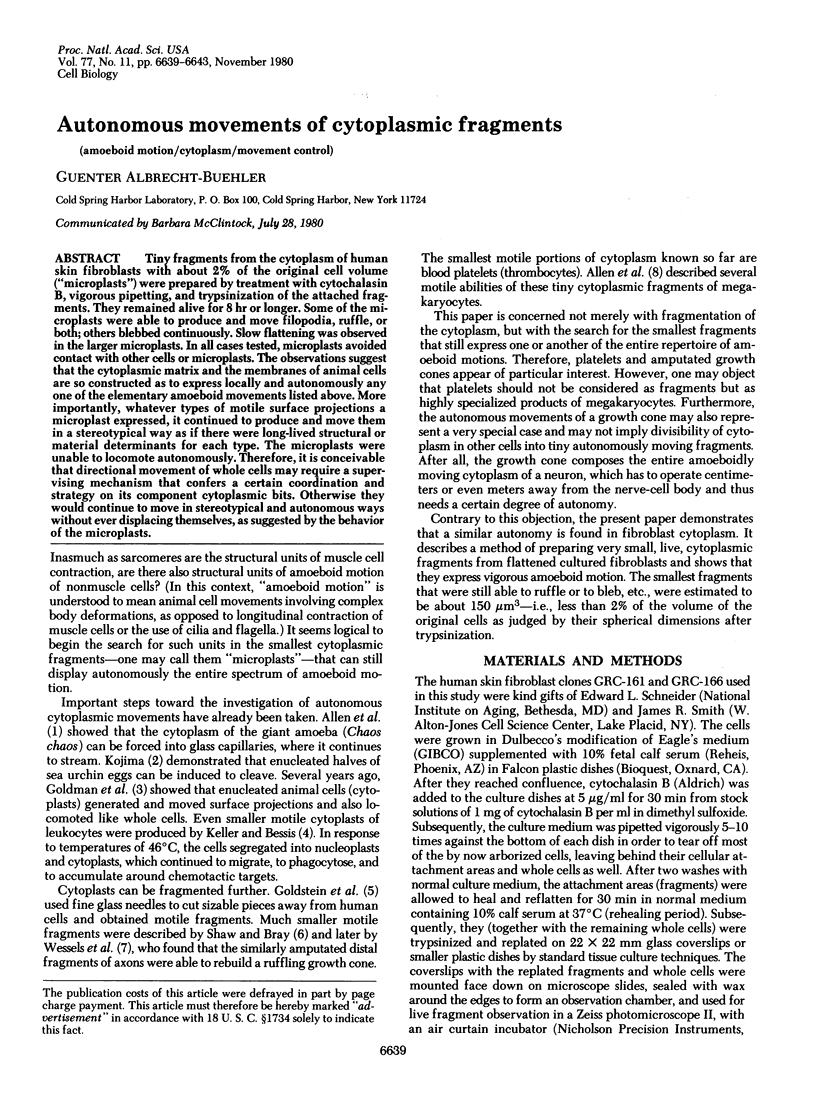Autonomous movements of cytoplasmic fragments (original) (raw)
Abstract
Tiny fragments from the cytoplasm of human skin fibroblasts with about 2% of the original cell volume ("microplasts") were prepared by treatment with cytochalasin B, vigorous pipetting, and trypsinization of the attached fragments. They remained alive for 8 hr or longer. Some of the microplasts were able to produce and move filopodia, ruffle, or both; others blebbed continuously. Slow flattening was observed in the larger microplasts. In all cases tested, microplasts avoided contact with other cells or microplasts. The observations suggest that the cytoplasmic matrix and the membranes of animal cells are so constructed as to express locally and autonomously any one of the elementary amoeboid movements listed above. More importantly, whatever types of motile surface projections a microplast expressed, it continued to produce and move them in a stereotypical way as if there were long-lived structural or material determinants for each type. The microplasts were unable to locomote autonomously. Therefore, it is conceivable that directional movement of whole cells may require a supervising mechanism that confers a certain coordination and strategy on its component cytoplasmic bits. Otherwise they would continue to move in stereotypical and autonomous ways without ever displacing themselves, as suggested by the behavior of the microplasts.

Images in this article
Selected References
These references are in PubMed. This may not be the complete list of references from this article.
- ALLEN R. D., COOLEDGE J. W., HALL P. J. Streaming in cytoplasm dissociated from the giant amoeba, Chaos chaos. Nature. 1960 Sep 10;187:896–899. doi: 10.1038/187896a0. [DOI] [PubMed] [Google Scholar]
- Allen R. D., Zacharski L. R., Widirstky S. T., Rosenstein R., Zaitlin L. M., Burgess D. R. Transformation and motility of human platelets: details of the shape change and release reaction observed by optical and electron microscopy. J Cell Biol. 1979 Oct;83(1):126–142. doi: 10.1083/jcb.83.1.126. [DOI] [PMC free article] [PubMed] [Google Scholar]
- GOLDSTEIN L., CAILLEAU R., CROCKER T. T. Nuclear-cytoplasmic relationships in human cells in tissue culture. II. The microscopic behavior of enucleate human cell iragments. Exp Cell Res. 1960 Mar;19:332–342. doi: 10.1016/0014-4827(60)90012-4. [DOI] [PubMed] [Google Scholar]
- Goldman R. D., Chojnacki B., Yerna M. J. Ultrastructure of microfilament bundles in baby hamster kidney (BHK-21) cells. The use of tannic acid. J Cell Biol. 1979 Mar;80(3):759–766. doi: 10.1083/jcb.80.3.759. [DOI] [PMC free article] [PubMed] [Google Scholar]
- Goldman R. D., Pollack R., Hopkins N. H. Preservation of normal behavior by enucleated cells in culture. Proc Natl Acad Sci U S A. 1973 Mar;70(3):750–754. doi: 10.1073/pnas.70.3.750. [DOI] [PMC free article] [PubMed] [Google Scholar]
- Gordon W. E., 3rd, Bushnell A. Immunofluorescent and ultrastructural studies of polygonal microfilament networks in respreading non-muscle cells. Exp Cell Res. 1979 May;120(2):335–348. doi: 10.1016/0014-4827(79)90393-8. [DOI] [PubMed] [Google Scholar]
- KOJIMA M. K. Acceleration of the cleavage of sea urchin eggs by vital staining with neutral red. Exp Cell Res. 1960 Sep;20:565–573. doi: 10.1016/0014-4827(60)90124-5. [DOI] [PubMed] [Google Scholar]
- Keller H. U., Bessis M. Migration and chemotaxis of anucleate cytoplasmic leukocyte fragments. Nature. 1975 Dec 25;258(5537):723–724. doi: 10.1038/258723a0. [DOI] [PubMed] [Google Scholar]
- Lazarides E. Actin, alpha-actinin, and tropomyosin interaction in the structural organization of actin filaments in nonmuscle cells. J Cell Biol. 1976 Feb;68(2):202–219. doi: 10.1083/jcb.68.2.202. [DOI] [PMC free article] [PubMed] [Google Scholar]
- Shaw G., Bray D. Movement and extension of isolated growth cones. Exp Cell Res. 1977 Jan;104(1):55–62. doi: 10.1016/0014-4827(77)90068-4. [DOI] [PubMed] [Google Scholar]
- Wessells N. K., Johnson S. R., Nuttall R. P. Axon initiation and growth cone regeneration in cultured motor neurons. Exp Cell Res. 1978 Dec;117(2):335–345. doi: 10.1016/0014-4827(78)90147-7. [DOI] [PubMed] [Google Scholar]